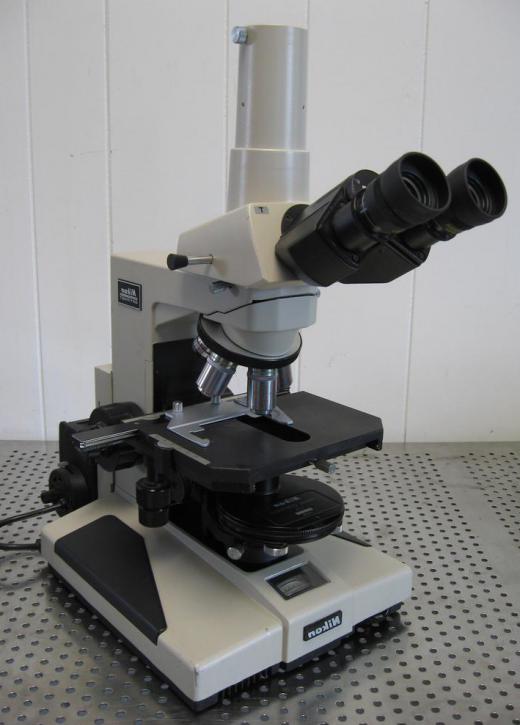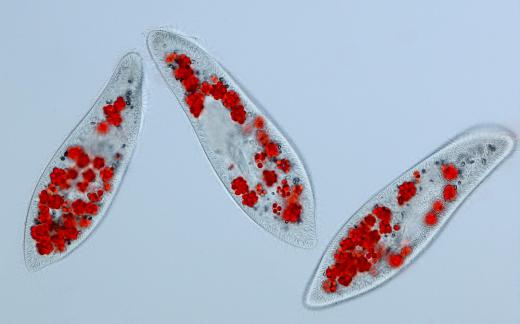What is a Contrast Microscope?
 Mary McMahon
Mary McMahon
A contrast microscope, more properly a phase contrast microscope, is a microscope with components which greatly increase the contrast of objects on the stage, making them highly visible. Using a contrast microscope allows someone to see clearly, visualizing the structures involved in the object on the stage, and this type of microscope also allows observers to see cells and organisms while they are still alive and going through their life cycles, a distinct advantage.
Many living cells have components which are transparent or very close to it. When viewed on a regular microscope, these components basically wash out, making it impossible to see them. One way to address this problem is to dye the organism, with the dye providing contrast which causes these structures to pop out. However, it can be difficult to dye specimens, and the dying process can change the cell structures in addition to killing the organism, which makes it unsuitable for people who want to see things alive under the microscope to better understand them.

The phase contrast microscope relies on the fact that light changes as it passes through an object. Depending on the refractive index of various parts of a cell, the light will slow down as it passes through, moving “out of phase,” as it is known. With a special filter known as a phase plate between the specimen and the eyepiece to amplify this change, the researcher will be able to clearly see the transparent structures without needing to dye the specimen.

Differences between a phase contrast microscope and a regular microscope can seem like night and day. A relatively boring slide will suddenly teem with life when viewed under a contrast microscope, and the detailed, delicate structures of organisms and cells will suddenly become visible when they were not before. Using contrast microscopy, scientists can watch microorganisms go through their life cycles, and they can also study the detailed anatomy of such organisms.
The inventor of the phase contrast technique, Frederik Zernike, was recognized with a Nobel Prize in 1953 for his efforts. Contrast microscopy can be significantly more expensive than other types of light microscopy, because it requires special equipment. As a result, phase contrast microscopes are usually only seen in specialized environments like research laboratories. Students in high level science classes at colleges and universities may be given an opportunity to work with such microscopes for their research and to learn more about the field.
AS FEATURED ON:
AS FEATURED ON:












Discussion Comments
@anamur-- There are really many different types of microscopes and all use different techniques and serve a different purpose. For example, the Darkfield microscope will give you an image of a cell as well but you won't see anything internal. If you use an electron microscope, you will have to dye the cell to see the different parts. You can use a fluorescence microscope but it uses ultraviolet light.
The phase contrast microscope doesn't have as good resolution as an electron microscope and it doesn't let you magnify the object as well as some other microscopes. But it's definitely the best microscope for looking at a cell's internal structure and that too while it is alive. So for someone who wants to observe a cell in its natural state, this is the best microscope for it.
You can even observe a human embryo with a contrast microscope and watch the different stages it goes through, live! Can it get better than that?
It sounds like an amazing piece of equipment for biologists and people who work in labs. It's too bad that it is too expensive for it to be widely available though.
What else are contrast microscopes good for observing? And is the contrast microscope the best microscope to observe cells?
Our instructor showed us images taken with a regular microscope and then images taken with a contrast microscope and there was a lot of difference. In the first one, the cells looked vague and all of them seemed to have the same color and density. In the second picture, everything was very defined and clear. We could see different colors of cells and even their textures.
It was sort of like using Photoshop and playing with the brightness and contrast and clarify options. The contrast microscope really makes a huge difference.
Post your comments